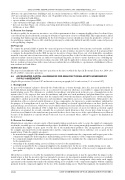Page 1134 - SAIT Compendium 2016 Volume2
P. 1134
EXPLANATORY MEMORANDUM ON THE TAXATION LAWS AMENDMENT BILL, 2015
allowance on capital structures (buildings) and, in certain circumstances, will be subject to a reduced corporate tax rate of 15 per cent instead of the current 28 per cent. To qualify for these income tax incentives, a company should:
• be tax resident in South Africa;
• operate within a designated SEZ;
• carry on business through a xed place of business situated within a designated SEZ; and
• have not less than 90 per cent of its income being derived from the carrying on of a business or rendering of services
within one or more SEZs.
II. Reason for change
In order to qualify for income tax incentives, one of the requirements is that a company should not have less than 90 per cent of its income derived from the carrying on of business or provision of services within SEZ. This requirement is aimed at ensuring that business pro ts qualifying for the lower business tax rate should arise from the productive activities of the qualifying company. There is still a risk that pro ts may be arti cially shifted from fully taxable connected persons to the qualifying company.
III. Proposal
To counter the potential shift of pro ts by connected person to bene t from the lower income tax bene ts available to companies operating within an SEZ, it is proposed that an anti-avoidance measure be introduced. It is proposed that a company be disquali ed from the SEZ income tax incentives if more than 20 per cent of its deductible expenditure incurred or income arises from transactions with connected persons.Due to the fact that transactions between resident and non-resident connected persons are subject to transfer pricing rules, in order to ensure that there is no ‘doubling-up’ of anti- avoidance measures, this anti-avoidance measure will only be applicable to transactions with connected persons that are resident or transactions with connected non-residents that are attributable to a permanent establishment of those non-residents in South Africa.
IV. Effective date
The proposed amendments will come into operation on the date on which the Special Economic Zones Act, 2014 (Act No.16 of 2014) comes into operation.
4.6 ACCELERATED CAPITAL ALLOWANCES FOR MANUFACTURING ASSETS GOVERNED BY SUPPLY AGREEMENTS
[Applicable provisions: Sections 12C and insertion on new paragraph (bA) to sub-section (1) of section 12C]
I. Background
As part of Government’s plans to diversify the South African economy through, inter alia, increased productivity in the South African manufacturing sector, an accelerated wear and tear allowance is available to support investment in manufacturing assets. The allowance is available for machinery and plant used in the process of manufacture in the instance that (1) the taxpayer that owns the machinery and plant uses such machinery and plant himself in a process of manufacture and (2) in the instance that the taxpayer that owns the machinery and plant leases out the machinery and plant to another person who then uses such machinery and plant in a process of manufacture. Subsequent to the introduction of the accelerated capital allowances, it was commonplace for taxpayers to acquire machinery and plant for the purpose of leasing them out at very low rentals. The resulting accelerated capital allowances on these leased assets generated large assessed losses, which were used to shield other non-related taxable income from taxation. To curb such abuse, limitations were introduced 1984 to limit these deductions for lessors of assets for which accelerated capital allowances are granted. As a result, currently the accelerated capital allowances that a lessor may claim in respect of leased assets are limited to the rental income generated by those assets. Any excess of the capital allowances not allowed because of the limitation is carried forward to the next year of assessment where, subject to again to the limitation in the next year.
II. Reason for change
Manufacturers sometimes outsource parts of their manufacturing operations in order to secure the supply of components used in the assembly process of manufactured products. In addition, these arrangements help manufacturers to establish and maintain the supply of spare parts over the life of the manufactured products. The arrangements are governed by a supply agreement between the manufacturer and the component supplier who in substance acts as agent for the manufacturer. Under the supply agreement –
• the manufacturer supplies the manufacturing assets necessary to manufacture the components and/or spare parts to the components supplier by delivering these manufacturing assets to the premises of the components supplier;
• the components supplier undertakes to use the manufacturing assets to manufacture the components and/or spare parts for the manufacturer;
• ownership of the manufacturing assets is all times reserved to the manufacturer;
• a rental is not payable by the component supplier to the manufacturer for the use of the manufacturing assets; and
• the component supplier is compensated by the manufacturer for the production of the necessary components and/or
spare parts.
Given that no rental is received by the manufacturer under these arrangements, it may be argued that the impact on the manufacturer is that the incentive that was intended to promote its investment in manufacturing assets is not available as a result of the limitation rule. Conversely, it may be argued that no lease arrangement exists under such supply agreements as the manufacturer makes the manufacturing assets available to the components supplier without requiring payment from the component supplier for the use of the manufacturing assets. Under this argument, the manufacturer is
1126 SAIT CompendIum oF TAx LegISLATIon VoLume 2


